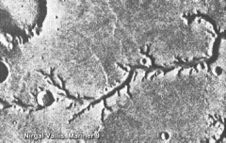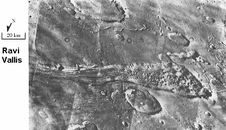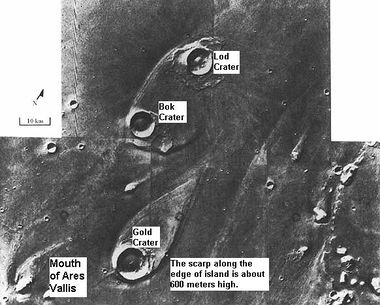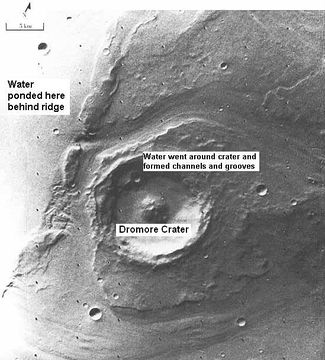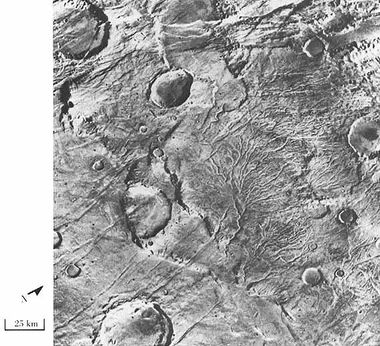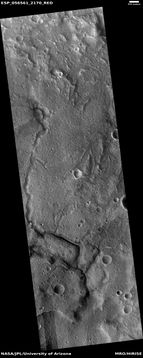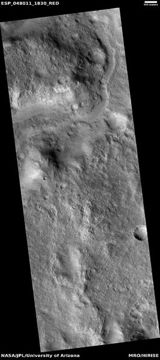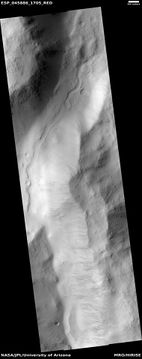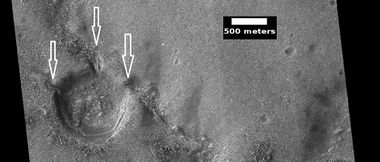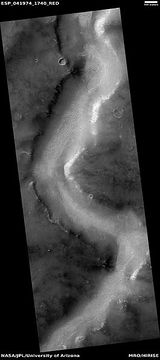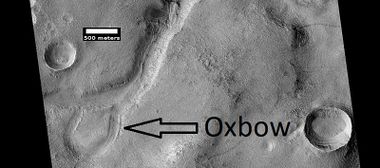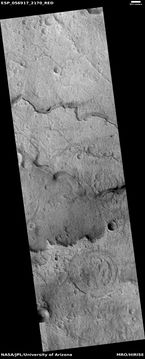Difference between revisions of "Rivers on Mars"
(→External links: added link) |
|||
| Line 11: | Line 11: | ||
| − | Researchers have grouped Martian river valleys into two groups. One type, called outflow channels, carried as much as or more water any on Earth and maybe at any time in Earth’s history. Rushing water formed large streamlined islands. Vast quantities of water seem to have just burst out of the ground.<ref> Baker, V.R. (1982). The Channels of Mars. Austin: Texas University Press.</ref> <ref> Carr, M. (1979). "Formation of Martian flood features by release of water from confined aquifers". J. Geophys. Res., 84, 2995-3007.</ref> <ref>Clifford, S. M.; Parker, T. J. (2001). "The Evolution of the Martian Hydrosphere: Implications for the Fate of a Primordial Ocean and the Current State of the Northern Plains". Icarus. 154 (1): 40–79. Bibcode:2001Icar..154...40C. doi:10.1006/icar.2001.6671</ref> <ref> Andrews-Hanna, J., R. Phillips. 2007. Hydrological modeling of outflow channels and chaos regions on Mars. Journal of Geophysical Research: Planets Volume 112, Issue E8 </ref> <ref>Clifford, S. 1993. A model for the hydrologic and climatic behavior of water on Mars. JGR, 98, 10973L </ref> The water originated in areas of collapsed terrain where the ground ended up formed into mesas and large blocks. This collapsed terrain has been called chaos.<ref> Carr, M.H. (2006), The Surface of Mars. Cambridge Planetary Science Series, Cambridge University Press.</ref> The water is thought to have flowed to lower elevations and created an ocean to the north that may have been one third the area of Mars.<ref>https://www.sciencedaily.com/releases/2010/06/100613181245.htm</ref> <ref> Gaetano Di Achille, Brian M. Hynek. Ancient ocean on Mars supported by global distribution of deltas and valleys. Nature, 2010; DOI: 10.1038/ngeo891</ref> Some researches postulated that floods erupted from the ground many times. Since Mars is very cold, ice would have quickly formed on the top and allowed the water to move along for some time. | + | Researchers have grouped Martian river valleys into two groups. One type, called outflow channels, carried as much as or more water any on Earth and maybe at any time in Earth’s history. Rushing water formed large streamlined islands. Vast quantities of water seem to have just burst out of the ground.<ref> Baker, V.R. (1982). The Channels of Mars. Austin: Texas University Press.</ref> <ref> Carr, M. (1979). "Formation of Martian flood features by release of water from confined aquifers". J. Geophys. Res., 84, 2995-3007.</ref> <ref>Clifford, S. M.; Parker, T. J. (2001). "The Evolution of the Martian Hydrosphere: Implications for the Fate of a Primordial Ocean and the Current State of the Northern Plains". Icarus. 154 (1): 40–79. Bibcode:2001Icar..154...40C. doi:10.1006/icar.2001.6671</ref> <ref> Andrews-Hanna, J., R. Phillips. 2007. Hydrological modeling of outflow channels and chaos regions on Mars. Journal of Geophysical Research: Planets Volume 112, Issue E8 </ref> <ref>Clifford, S. 1993. A model for the hydrologic and climatic behavior of water on Mars. JGR, 98, 10973L </ref> The water originated in areas of collapsed terrain where the ground ended up formed into mesas and large blocks. This collapsed terrain has been called chaos.<ref> Carr, M.H. (2006), The Surface of Mars. Cambridge Planetary Science Series, Cambridge University Press.</ref> The water is thought to have flowed to lower elevations and created an ocean to the north that may have been one third the area of Mars.<ref>https://www.sciencedaily.com/releases/2010/06/100613181245.htm</ref> <ref> Gaetano Di Achille, Brian M. Hynek. Ancient ocean on Mars supported by global distribution of deltas and valleys. Nature, 2010; DOI: 10.1038/ngeo891</ref> Some researches postulated that floods erupted from the ground many times. Since Mars is very cold, ice would have quickly formed on the top and allowed the water to move along for some time. Scientists generally agree that Mars has a thick shell of ice under the surface.<ref>Clifford, S. 1993. A model for the hydrologic and climatic behavior of water on Mars. Geophys. Res. 98 (E6)</ref> Perhaps in the past there was a vast interconnected layer of water under it. If an asteroid, fault, or volcanic eruption caused the ice to break, water could pour out. <ref>Carr, M. 1979. Formation of martian flood features by release of water from confined aquifers. J. Geophys. Res. 84: 2995-3007.</ref> <ref>ISBN 978-0-521-87501-0 Please check ISBN|reason=Check digit (0) does not correspond to calculated figure.</ref> <ref>Hanna, J. and R. Phillips. 2005. Tectonic pressurization of aquifers in the formation of Mangala and Athabasca Valles on Mars. LPSC XXXVI. Abstract 2261.</ref> |
Revision as of 16:47, 7 July 2020
Article written by Jim Secosky. Jim is a retired science teacher who has used the Hubble Space Telescope, the Mars Global Surveyor, and HiRISE.
There is much evidence that water once flowed in river valleys on Mars. Images of curved and branched channels have been seen in images from Mars spacecraft dating back to the early seventies with the Mariner 9 orbiter. [1] [2] [3] [4] [5] [6] These river valleys are called Vallis (plural Valles), the Latin word for valley.
Contents
Outflow Channels
Researchers have grouped Martian river valleys into two groups. One type, called outflow channels, carried as much as or more water any on Earth and maybe at any time in Earth’s history. Rushing water formed large streamlined islands. Vast quantities of water seem to have just burst out of the ground.[7] [8] [9] [10] [11] The water originated in areas of collapsed terrain where the ground ended up formed into mesas and large blocks. This collapsed terrain has been called chaos.[12] The water is thought to have flowed to lower elevations and created an ocean to the north that may have been one third the area of Mars.[13] [14] Some researches postulated that floods erupted from the ground many times. Since Mars is very cold, ice would have quickly formed on the top and allowed the water to move along for some time. Scientists generally agree that Mars has a thick shell of ice under the surface.[15] Perhaps in the past there was a vast interconnected layer of water under it. If an asteroid, fault, or volcanic eruption caused the ice to break, water could pour out. [16] [17] [18]
Valley Networks
Another type of channel exists mostly in the old, southern highlands. They were discovered by Mariner 9 in 1971. Sometimes called valley networks, these channels closely resemble streams in drainage basins on the Earth. The channels are branched (dendritic). However, branches are typically shorter on Mars than on the Earth. [19] Also, most channels do not exhibit a high branching density. But, in some places the stream branches are, in fact, as dense as some on Earth.[20] Many look as if they were made with precipitation. Further support for abundant water flow, came from a research team that developed a computer program to look for valleys made by streams found that the stream networks were much longer than previous thought (2.3 times longer) and that they were much denser. Valleys were especially dense in northern Terra Cimmeria and the Margaritifer Terra. There results suggest that precipitation may have caused them.[21] [22] [23]
Channels displaying curves, wide meanders, oxbow lakes, and wide meanders are similar to those on Earth. Many channels end in low areas such as craters. At times, deltas form where the stream enters a crater; they look like a stream entering a lake. Some small streams are found on valley floors. Stream channels on valley floors imply more than one episode of flow.[24] [25]
Even though some channels go for relative short distances, some may run for hundreds or thousands of kilometers. One long system of lakes and rivers may reach from the far south to the far north. [26] [27] [28] In a study released in 2018, researchers found 34 palelakes and associated channels in the northeastern Hellas Basin. Because some were close to the Hadriacus volcano, some channels may have been created by hydrothermal systems; thereby allowing ice to melt. A number look as if they were formed from precipitation others from groundwater.[29] [30] [31]
Was Mars too cold for running water?
It seems that these valley networks happened in the past when Mars was much warmer and wetter. But, climate models all say that Mars was always too cold to have much liquid water. The sun is too far away. It likely did not give off as much light energy in the past.[32] [33] [34] Another factor that could still have made the climate warmer is that the atmosphere may have been much thicker in the past and could have contained greenhouse gases like carbon dioxide. However, if this were the case, carbon dioxide would have ended up in large deposits of carbonate rocks such as limestone.[35] Despite looking with instruments designed to detect carbonates, scientists have found very little. [36] They do exist in tiny areas, have been found in meteorites that came from Mars, and have been found by landers, but there just does not seem to be enough to say that Mars once had a thick carbon dioxide atmosphere. [37] [38] [39] [40] [41] Some researchers have proposed that other greenhouse gases may have been involved.[42] [43] So we are left with what appears to be certain proof that Mars had great amounts of liquid water—somehow channels were made. On the other hand, we do not know how the climate could have ever supported very much liquid water.[44] Nevertheless, scientists have suggested many ways for channels to be created. We must keep in mind that the planet does not have to that warmed to 32 degrees F for running water to exist because water on Mars would likely contain dissolved minerals that would lower its freezing point.[45] Also, water may have collected in vast aquifers under the ground and released at different times by things such as heating from magma moving underground or by impacts of asteroids. After large impacts, the nearby area might be warm enough, long enough for water to erode channels.[46] [47] [48] [49] [50] [51] [52] [53] It has even been suggested that the weather after a big impact may be changed enough to generate rainfall.[54] [55] [56] Some researchers think that streams may have existed under thick ice sheets. [57] [58] [59] As of today, we just do not have a definite answer.
References
- ↑ Baker, V. 1982. The Channels of Mars. Univ. of Tex. Press, Austin, TX
- ↑ Baker, V., R. Strom, R., V. Gulick, J. Kargel, G. Komatsu, V. Kale. 1991. Ancient oceans, ice sheets and the hydrological cycle on Mars. Nature 352, 589–594.
- ↑ Carr, M. 1979. Formation of Martian flood features by release of water from confined aquifers. J. Geophys. Res. 84, 2995–300.
- ↑ Komar, P. 1979. Comparisons of the hydraulics of water flows in Martian outflow channels with flows of similar scale on Earth. Icarus 37, 156–181.
- ↑ http://advances.sciencemag.org/content/5/3/eaav7710
- ↑ Kite, E., et al. 2019. Persistence of intense, climate-driven runoff late in Mars history. Science Advances: 5, eaav7710
- ↑ Baker, V.R. (1982). The Channels of Mars. Austin: Texas University Press.
- ↑ Carr, M. (1979). "Formation of Martian flood features by release of water from confined aquifers". J. Geophys. Res., 84, 2995-3007.
- ↑ Clifford, S. M.; Parker, T. J. (2001). "The Evolution of the Martian Hydrosphere: Implications for the Fate of a Primordial Ocean and the Current State of the Northern Plains". Icarus. 154 (1): 40–79. Bibcode:2001Icar..154...40C. doi:10.1006/icar.2001.6671
- ↑ Andrews-Hanna, J., R. Phillips. 2007. Hydrological modeling of outflow channels and chaos regions on Mars. Journal of Geophysical Research: Planets Volume 112, Issue E8
- ↑ Clifford, S. 1993. A model for the hydrologic and climatic behavior of water on Mars. JGR, 98, 10973L
- ↑ Carr, M.H. (2006), The Surface of Mars. Cambridge Planetary Science Series, Cambridge University Press.
- ↑ https://www.sciencedaily.com/releases/2010/06/100613181245.htm
- ↑ Gaetano Di Achille, Brian M. Hynek. Ancient ocean on Mars supported by global distribution of deltas and valleys. Nature, 2010; DOI: 10.1038/ngeo891
- ↑ Clifford, S. 1993. A model for the hydrologic and climatic behavior of water on Mars. Geophys. Res. 98 (E6)
- ↑ Carr, M. 1979. Formation of martian flood features by release of water from confined aquifers. J. Geophys. Res. 84: 2995-3007.
- ↑ ISBN 978-0-521-87501-0 Please check ISBN|reason=Check digit (0) does not correspond to calculated figure.
- ↑ Hanna, J. and R. Phillips. 2005. Tectonic pressurization of aquifers in the formation of Mangala and Athabasca Valles on Mars. LPSC XXXVI. Abstract 2261.
- ↑ Baker, V. , and J. Partridge. 1986. Small Martian valleys: Pristine and degraded morphology, J. Geophys. Res., 91, 3561–3572.
- ↑ Hynek, B.M., and Phillips, R. 2001. Evidence of extensive denudation of the martian highlands, Geology, 29, 407-10
- ↑ https://www.astrobio.net/mars/martian-north-once-covered-by-ocean/
- ↑ Luo, W., T. Stepinski. 2009. Computer‐generated global map of valley networks on Mars. Journal of Geophysical Research: Planets: 114, Issue E11. https://doi.org/10.1029/2009JE003357.
- ↑ https://agupubs.onlinelibrary.wiley.com/doi/full/10.1029/2009JE003357
- ↑ Malin, M.C., and Carr, M.H. (1999), Groundwater formation of martian valleys, Nature, 397, 589-592
- ↑ Jaumann, R. (2005), Martian valley networks and associated fluvial features as seen by the Mars Express High Resolution Camera (HRSC), LPSC XXXVI, Abstract 1815
- ↑ Cabrol, N., E. Grin. 1999. Distribution, classification, and ages of martian impact crater lakes. Icarus: 142, 160-172.
- ↑ Irwin, R.; et al. (2005). "An intense terminal epoch of widespread fluvial activity on early Mars. 2. Increased runoff and paleolake development". J. Geophys. Res. 110.
- ↑ Fassett, C.; Head, J. (2008). "Valley network-fed, open-basin lakes on Mars: Distribution and implications for Noachian surface and subsurface hydrology". Icarus. 198: 37–56.
- ↑ https://www.liebertpub.com/doi/abs/10.1089/ast.2018.1816?journalCode=ast
- ↑ https://www.seti.org/groundwater-and-precipitation-provided-water-form-lakes-along-northern-rim-hellas-basin-throughout
- ↑ Hargitai, H., et al. 2018. Groundwater-Fed, and Fluvial Lakes in the Navua–Hadriacus–Ausonia Region, Mars. Astrobiology: 18. (11). https://doi.org/10.1089/ast.2018.1816
- ↑ Wordsworth, R., et al. 2015. Comparison of “warm and wet” and “cold and icy” scenarios for early Mars in a 3‐D climate model. Journal of Geophysical Research: Planets Volume 120, Issue 6. https://doi.org/10.1002/2015JE004787.
- ↑ Squyres, S., J. Kasting. 1994. Early Mars: How Warm and How Wet? Science : Vol. 265, Issue 5173, pp. 744-749.
- ↑ Catling, D. C. (2007). Mars: Ancient fingerprints in the clay. Nature. 448 (7149): 31–32.
- ↑ http://www.psrd.hawaii.edu/Oct03/carbonatesMars.html
- ↑ Murchie, S., et al. 2009. A synthesis of Martian aqueous mineralogy after 1 Mars years of observations from the Mars Reconnaissance Orbiter. Journal of Geophysical Research: 114, E00D06
- ↑ McKay, C., et al. 1996. Search for Past Life on Mars: Possible Relic Biogenic Activity in Martian Meteorite ALH84001. Science: 273, 924-930
- ↑ https://www.webelements.com/nexus/carbonate-minerals-on-mars/
- ↑ https://mars.nasa.gov/mer/newsroom/pressreleases/20040109a.html
- ↑ Pollack, J. B, Roush, T., Witteborn, F., Bregman, J., Wooden, D., Stoker, C., Toon, O. B., Rank, D., Dalton, B., and Freedman, R. (1990) Thermal emission spectra of Mars (5.4-10.5 microns): evidence for sulfates, carbonates, and hydrates, Journal of Geophysical Research, v. 95 (B9), p. 14595-14627.
- ↑ https://mars.nasa.gov/resources/4040/carbonate-containing-martian-rocks/
- ↑ Ramirez, R. M., Kopparapu, R., Zugger, M. E., Robinson, T. D., Freedman, R., & Kasting, J. F. 2014. Warming early Mars with CO2 and H2. Nature Geoscience, 7(1), 59-63.
- ↑ Wordsworth, R., Kalugina, Y., Lokshtanov, S., Vigasin, A., Ehlmann, B., Head, J., ... & Wang, H. 2017. Transient reducing greenhouse warming on early Mars. Geophysical Research Letters, 44(2), 665-671.
- ↑ Haberle, R.M. 1998. Early Climate Models, J. Geophys. Res., 103(E12), 28467-79.
- ↑ Fairen, A., et al. 2009. Stability against freezing of aqueous solutions on early Mars. Nature: 459, 401-404
- ↑ https://www.hou.usra.edu/meetings/lpsc2019/pdf/2024.pdf
- ↑ Palumbo, A., J. Head. OCEANS ON MARS: THE POSSIBILITY OF A NOACHIAN GROUNDWATER-FED OCEAN IN A SUBFREEZING MARTIAN CLIMATE. 50th Lunar and Planetary Science Conference 2019 (LPI Contrib. No. 2132). 2024.pdf
- ↑ Newsome, H.E. (1980), Hydrothermal alteration of impact melt sheets with implications for Mars, Icarus, 44, 207-16.
- ↑ Mangold, N., V. Ansan, P. Masson, C. Quantin, and G. Neukum. 2008. Geomorphic study of fluvial landforms on the northern Valles Marinerisplateau, Mars, J. Geophys. Res., 113, E08009, doi:10.1029/2007JE002985.
- ↑ Segura, T. L., O. B. Toon, and T. Colaprete. 2008. Modeling the environmentaleffects of moderate‐sized impacts on Mars, J. Geophys. Res., 113,E11007, doi:10.1029/2008JE003147
- ↑ Segura, T. L., O. B. Toon, T. Colaprete, and K. Zahnle. 2002. Environmental Effects of Large Impacts on Mars, Science, 298, 1977–1980. doi:10.1126/science.1073586
- ↑ Kraal, E. R., M. van Dijk, G. Postma, and M. G. Kleinhans 2008b. Martian stepped‐delta formation by rapid water release, Nature, 451. 973–976, doi:10.1038/nature06615
- ↑ Toon, O. B., T. Segura, and K. Zahnle. 2010. The formation of Martian river valleys by impacts, Annu. Rev. Earth Planet. Sci., 38, 303–322. doi:10.1146/annurev-earth-040809-152354
- ↑ https://arxiv.org/abs/1902.07666
- ↑ Turbet, M., et al. 2019. The environmental effects of very large bolide impacts on early Mars explored with a hierarchy of numerical models. Submitted to Icarus
- ↑ https://www.space.com/mars-water-from-massive-impacts.html?utm_source=sdc-newsletter&utm_medium=email&utm_campaign=20190305-sdc
- ↑ https://www.hou.usra.edu/meetings/lpsc2019/pdf/2574.pdf
- ↑ Galofre, G., et al. 2019. DID MARTIAN VALLEY NETWORKS FORM UNDER ANCIENT ICE SHEETS? 50th Lunar and Planetary Science Conference 2019 (LPI Contrib. No. 2132). 2574.pdf
- ↑ Squyres, S.W., and Kasting, J.F. 1994. Early Mars: How warm and how wet?, Science, 265, 744-8.
See Also
- Glaciers on Mars
- High Resolution Imaging Science Experiment (HiRISE)
- How living on Mars will be different than living on Earth
- Martian features that are signs of water ice
- Oceans on Mars
